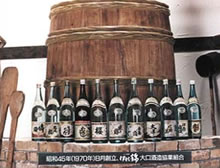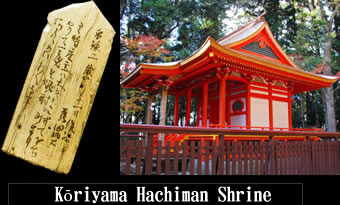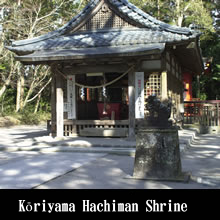A Hometown Shochu
Water, rice, and sweet potatoes of the highest quality are indispensable for crafting delicious shochu. The Isa region (encompassing Okuchi and Hishikari) in Kagoshima Prefecture is home to Isa-mai rice, famed for its great flavor. The area is naturally blessed with spring waters and a relatively cold climate. This natural environment is what gave rise to Isa Shochu.

At Kōriyama Hachiman Shrine, the oldest example of the two Chinese characters for shochu was discovered on one of the structure’s pillars. Isa Shochu was so fervently popular with the great author Chogoro Kaionji to warrant being called “Hometown Shochu.” Isa Shochu, supported by its long history and tradition, has lasted until today.
In much earlier times, there were 13 deistilleries in Isa. In time, 11 banded together as an industrial alliance, unifying the Isanishiki brand and inaugurating Okuchi Shuzo Co., Ltd. in 1970. With two other collaborators (Isami’s Kai Shoten, in Okuchi, Isa, and Isadaisen’s Oyama Shuzo, in Hishikari, Isa), Okuchi Shuzo fosters and supports the Isa Shochu of today.
Also called Satsuma Shochu, the name of Kagoshima Prefecture’s shochu is protected internationally as a place-of-origin trademark (excluding Oshima county, Naze city). However, the shochu made in Isa city (called Isa Shochu) is the mainstay inside the prefecture. There are few examples of regions like this where one area’s spirit becomes synonymous with the entire prefecture’s product.
When Okuchi Shuzo was founded, Isa shochu was even mentioned in a letter from Naoki Prize-winning author Chogoro Kaionji, a native of Okuchi City.
The history of shochu begins here.

Isa City—the hometown of Isanishiki. Isa City still remains the home base for shochu. Kōriyama Hachiman Shrine, one of Japan’s Important Cultural Assets. When disassembled for maintenance work in 1954, graffiti left by the shrine builders from more than 400 years ago was found on one of the pillars.
The graffiti, dated to the second year of the Eiroku Era (1559), read something to the effect of, “The stingy owner didn’t even give us one bottle of shochu.” These two Chinese characters reading shochu are an ancient record of Japan’s first known use of the word.
They came in a historical context of shochu consumption in this region, which is what reportedly made Isa City the birthplace of the spirit.
*The second year of the Eiroku Era, 1559 (Muromachi Period)
The Muromachi Shogunate (1336-1573) was a ruling military administration founded by Takauji Ashikaga. It is also referred to as the Ashikaga Shogunate. As the shogun’s residence eventually moved to Muromachi, Kyoto, the period is generally called the Muromachi Shogunate. The administration was weakened by the Ōnin War (1467-1477), bringing about an inverted social order with retainers supplanting their lords. Toward the end of the period, feudal daimyo lords gained power in areas across Japan and the shogunate came to exist in name only.
However, the culture of samurai houses flourished (exemplified by the Kitayama and Higashiyama schools) and trade with Ming Dynasty China grew, bringing in new cultural influences. In 1573, 15th Shogun Yoshiaki Ashikaga was driven out by Nobunaga Oda, closing the curtain on the shogunate government.
Kōriyama Hachiman Shrine
According to shrine lore, Jumyo Hishikari, founder of the Hishikari Clan, received land in the 4th year of the Kenyu Era (1193). In August of the 5th year of the Kenyu Era (1194), when patrolling his property, he happened upon an old man at Koriyama. The old man told him, “I am Usahachiman of Buzen province. If you enshrine me here, I will protect your offspring and pray for their prosperity.” Jumyo believed this message and beseeched the deity of Buzen Usahachiman to migrate to this new shrine, which has continued to tell the story to this day.

The main hall (with Irimoya-styled (hip-and-gable) single-layer shingled roof) has 5.43-m long beams with a span of 5.43 m, while the inner hall (with Irimoya-styled single-layer tanabuki roof) has 1.81-m long beams with a span of 1.81 m. The structure’s architecture has strong accents of Muromachi and Momoyama-style techniques, as well as Ryukyu designs.
Initially, the architectural period was not clear, though writing in the carpenter’s bamboo marking brush on the reverse of the shingles reads “1507, Teibo reconstruction, Lord Shimazu Dewa,” showing that Hachiman Shrine was constructed prior to that year.
The current main hall was repaired and reconstructed in 1954.
Isanishiki—dearly beloved by literary giant Chogoro Kaionji
Satsuma Shochu, the shochu of my home region, is the best in Japan.


“Satsuma Shochu is the best in Japan…no, in all the world… And among the varieties of Satsuma Shochu, the preeminent brand recognized in Kagoshima Prefecture is Isa County’s shochu. It is the shochu of my home.”
These words are high praise for Isanishiki by uncompromising historical novelist and Naoki Prize winner Chogoro Kaionji. The aggressive, yet soothing flavor even won over the literary maestro of the region.
Even the characters inscribed on the Satsuma Shochu Isanishiki label are those copied from the author’s hand-written message.
Chogoro Kaionji
Born on November 5, 1901 in what is now Okuchi in Isa City on the border between northern Kagoshima Prefecture and Kumamoto Prefecture. His notable works include Ten-to Chi-to, Saigo Takamori, and Busho Retsuden.
Nihon-no Ginnan and other masterpieces exemplify Kaionji’s literary style, with some of his novels set in his hometown of Okuchi. The short story Tabaruzaka was also set in Okuchi and draws on the events of the Satsuma Rebellion.
*As of the latter half of 2013, Kaionji is the only native of Kagoshima Prefecture to have received the Naoki Prize or Akutagawa Prize.